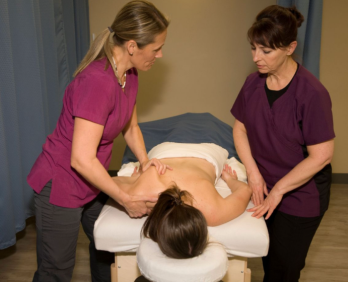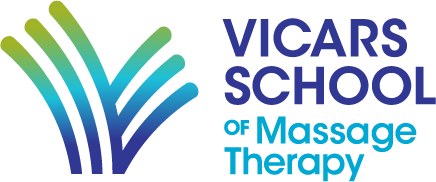When you’re a massage therapist, getting injured on the job hurts more than just your body. Taking time off to recover from an injury means loss of income, and even potential loss of clients.
The best way for an RMT to deal with workplace injury is to ensure that it doesn’t happen in the first place. And that means a focus on body mechanics—the right way to move—so that soft tissue and joints stay injury free.
The path to a long injury-free massage career
In 2001, Vicars School of Massage Therapy was founded, there was a prevalent myth that massage was a very short career.
“The idea was that injury was inevitable, but we knew that was just not true,” says founder Maryhelen Vicars. “There was lots of evidence that students who had early and consistent training in correct body mechanics and self-care had a huge advantage in staying safe and pain free.
“From the first, our program was modelled after the curriculum in Ontario, one of the first provinces to regulate massage therapy education. For decades, massage schools in regulated provinces have incorporated safety and injury prevention in their practical training.”
So the Vicars curriculum did the same.
“From the first day of instruction, students learn body mechanics in our core science courses of anatomy and physiology,” says Curriculum Director Linda McGeachy. “And they put that knowledge into practice in class. During hands-on instruction and practice, students are monitored by instructors not just for technique, but for attention to their own body mechanics.”
At Vicars School, body mechanics is a structured part of the curriculum, and includes techniques for core stability, keeping joints in straight alignment and applying pressure appropriately. “There isn’t just one way of doing anything,” says McGeachy. “Instructors correct for stance, posture and pressure, and they also encourage students to listen to their own bodies.”
Different body shapes and sizes mean that students need to be able to adapt a theoretical “perfect form” into positions that work for their own bodies.
Preventing overuse
The most common injuries directly result from overuse and such injuries are the most preventable, says McGeachy. “Hands, elbows and shoulders are subject to overuse if we don’t use our bodies properly,” she says. “In addition to listening to their bodies, RMTs need to ensure they don’t overuse their bodies by booking too many clients in a day, especially when they first start their careers.”
Awareness of strengths, coordination and mobility are vital, as is the need to adjust techniques depending on the client. She also points out that new information resulting from research and outcomes-based approaches to attitudes about what massage should be, are informing awareness of injury prevention.
With practical experience comes knowledge about not overloading muscles and joints and using “relative rest”—a recovery technique that protects and rests the injured area while continuing to be active with other parts of your body.
Less is more
We’ve all seen memes of massage therapists reducing their clients to tears and whimpers. But that is as outdated as the idea of “no pain, no gain” in gyms and sports fields.
One of the most important changes, says McGeachy, is that the concept of a heavy, load-bearing workout on tissue as the only way to get results has lost its credence. “It’s more about understanding how to work on tissue rather than simply pushing down hard on it,” she says. “Understanding physiology and what tissue is, means that we don’t have to create pain in order to get results.”
Quite the opposite, in fact. Current knowledge about massage’s benefits reinforces a pain-management approach to therapeutic massage.
RMTs are educated about repetitive strain injury and overuse and they in turn educate their clients. Key to that education, says McGeachy, is movement. “If you are planning to do a physical activity, then do the movements of it as a warm-up.” She points out that any exercise will carry restrictions for someone, depending on their body. “It’s not that the exercise—whether it’s yoga or tennis or gardening—is harmful; it’s that you have to be aware of your body and when something hurts, move away from that position,” she says.
Using brain power for body power
Using a research-based curriculum, instructors at Vicars School encourage students to build on their understanding of body mechanics and principles with critical thinking skills. “This means students have confidence acting on their own understanding of when something doesn’t feel good, and how to adjust their technique by using a different position that feels better,” says McGeachy. “From our school perspective, even if a student’s body mechanics aren’t ‘textbook’, the important thing is that they are learning to prevent injuring themselves.”
Piloting a new movement course
Building on the importance of movement as foundational for injury prevention and career health, the Vicars School curriculum will be piloting a new course in September, based on a resource called Trail Guide to Movement.
“We already have rich material on movement, including orthopedic assessment courses and gait analysis,” says Linda McGeachy. “But this will really augment our existing curriculum and delve into movement as core in keeping a health body and promoting longevity in our careers.”
written by Kathleen Thurber
Start your long and successful massage therapy career at Vicars School! We have campuses in Calgary and Edmonton and schedules that are designed to work with your lifestyle. For more information and to speak with our friendly admissions team, call us toll-free 1-866-491-0574 or sign up for an online open house!





